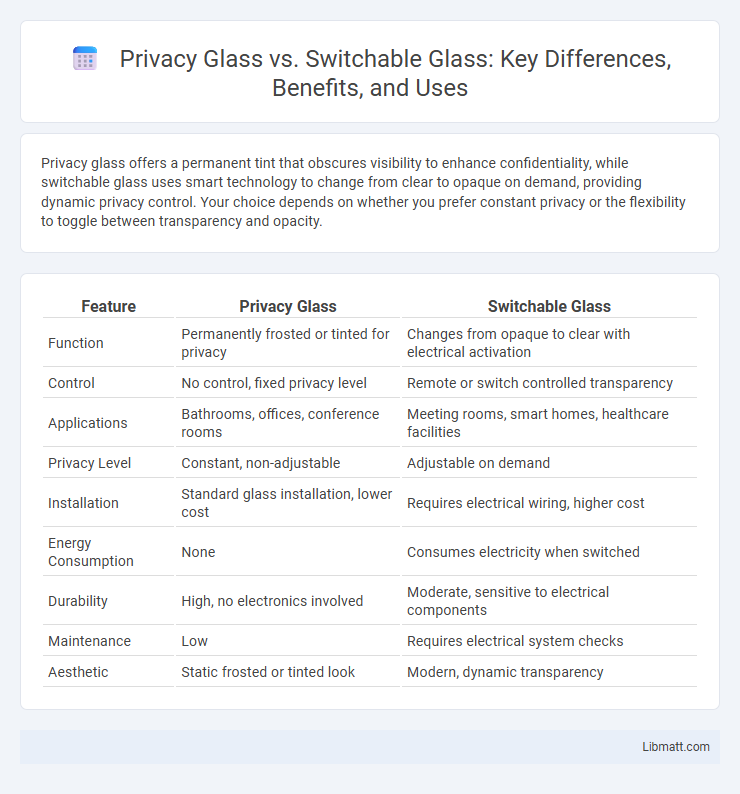Privacy glass offers a permanent tint that obscures visibility to enhance confidentiality, while switchable glass uses smart technology to change from clear to opaque on demand, providing dynamic privacy control. Your choice depends on whether you prefer constant privacy or the flexibility to toggle between transparency and opacity.
Table of Comparison
| Feature | Privacy Glass | Switchable Glass |
|---|---|---|
| Function | Permanently frosted or tinted for privacy | Changes from opaque to clear with electrical activation |
| Control | No control, fixed privacy level | Remote or switch controlled transparency |
| Applications | Bathrooms, offices, conference rooms | Meeting rooms, smart homes, healthcare facilities |
| Privacy Level | Constant, non-adjustable | Adjustable on demand |
| Installation | Standard glass installation, lower cost | Requires electrical wiring, higher cost |
| Energy Consumption | None | Consumes electricity when switched |
| Durability | High, no electronics involved | Moderate, sensitive to electrical components |
| Maintenance | Low | Requires electrical system checks |
| Aesthetic | Static frosted or tinted look | Modern, dynamic transparency |
Understanding Privacy Glass: Definition and Features
Privacy glass, commonly known as tinted or frosted glass, offers a permanent solution for obscuring visibility while allowing light to pass through, utilizing embedded pigments or coatings to reduce transparency. It features high durability, low maintenance, and consistent privacy as its opacity does not change with electric current or light conditions. Unlike switchable glass, privacy glass cannot be altered on demand, making it ideal for static privacy needs in automotive, architectural, and interior design applications.
What is Switchable Glass? Key Characteristics
Switchable glass, also known as smart glass, is a technology-enabled glass that can change from transparent to opaque using an electric current. Key characteristics include privacy control, energy efficiency by reducing heat and glare, and versatility for applications in offices, homes, and automotive uses. You can easily adjust the transparency to enhance privacy without sacrificing natural light.
Privacy Glass vs Switchable Glass: Core Differences
Privacy glass uses a permanent tint or film to obscure visibility by darkening the window, providing consistent privacy without the need for power. Switchable glass, also known as smart glass, relies on an electrochromic or PDLC film that changes opacity when an electric current is applied, allowing dynamic control over transparency. Key differences include privacy glass's static opacity versus switchable glass's adjustable privacy, with the latter offering modern flexibility at a higher cost and energy requirement.
Installation Processes: Privacy Glass Compared to Switchable Glass
Privacy glass involves a straightforward installation process similar to standard tinted or frosted windows, requiring minimal electrical work since it relies on permanent opacity. Switchable glass demands a more complex installation, integrating electrical wiring and control systems to enable transition between transparent and opaque states using smart film technology. Your choice impacts installation time and cost, with privacy glass offering simplicity and switchable glass providing dynamic privacy control.
Smart Technology Integration: Switchable vs Privacy Glass
Switchable glass incorporates smart technology that allows you to control transparency with a simple switch or app, transitioning from clear to opaque for instant privacy and energy efficiency. Privacy glass offers a static solution, featuring a permanent frosted or tinted finish that limits visibility but lacks dynamic control or integration with automation systems. For seamless smart home or office setups, switchable glass provides enhanced functionality through its compatibility with IoT devices, while privacy glass remains a cost-effective option without connectivity features.
Energy Efficiency and Environmental Impact
Privacy glass enhances energy efficiency by reducing solar heat gain, which lowers cooling costs and minimizes energy consumption in buildings and vehicles. Switchable glass offers dynamic control over light and heat transmission, allowing users to optimize energy use by adjusting opacity based on environmental conditions. Both technologies contribute to environmental sustainability by decreasing reliance on artificial lighting and HVAC systems, but switchable glass provides greater adaptability for energy management.
Aesthetic and Design Flexibility
Privacy glass offers a sleek, tinted look that seamlessly integrates with vehicle exteriors but lacks dynamic transparency control. Switchable glass provides superior design flexibility by enabling instant opacity changes through electrical activation, allowing interiors to shift between privacy and openness without compromising natural light. This innovative technology supports modern architectural aesthetics by combining functionality with customizable visual effects.
Cost Comparison: Privacy Glass vs Switchable Glass
Privacy glass typically costs less upfront than switchable glass, making it a budget-friendly option for basic privacy needs. Switchable glass involves higher installation and technology expenses due to its electronic components and specialized controls. Your choice depends on balancing cost with the desired level of functionality and control over transparency.
Common Applications in Residential and Commercial Spaces
Privacy glass is commonly used in residential settings such as bathroom windows, bedroom partitions, and conference rooms to ensure a consistent opaque barrier for enhanced privacy. Switchable glass finds applications in commercial spaces like offices, hotels, and healthcare facilities, where its ability to toggle between transparent and opaque states offers flexible privacy and light control. Your choice depends on whether consistent privacy or dynamic adaptability suits your space requirements.
Choosing the Right Solution: Factors to Consider
When choosing between privacy glass and switchable glass, consider factors such as control preferences, budget, and installation requirements. Privacy glass offers a permanent frosted or tinted appearance, while switchable glass provides on-demand transparency using electric current, ideal for dynamic spaces. Your decision should align with usage frequency, energy consumption, and maintenance expectations to ensure the optimal balance between privacy and functionality.
privacy glass vs switchable glass Infographic

 libmatt.com
libmatt.com